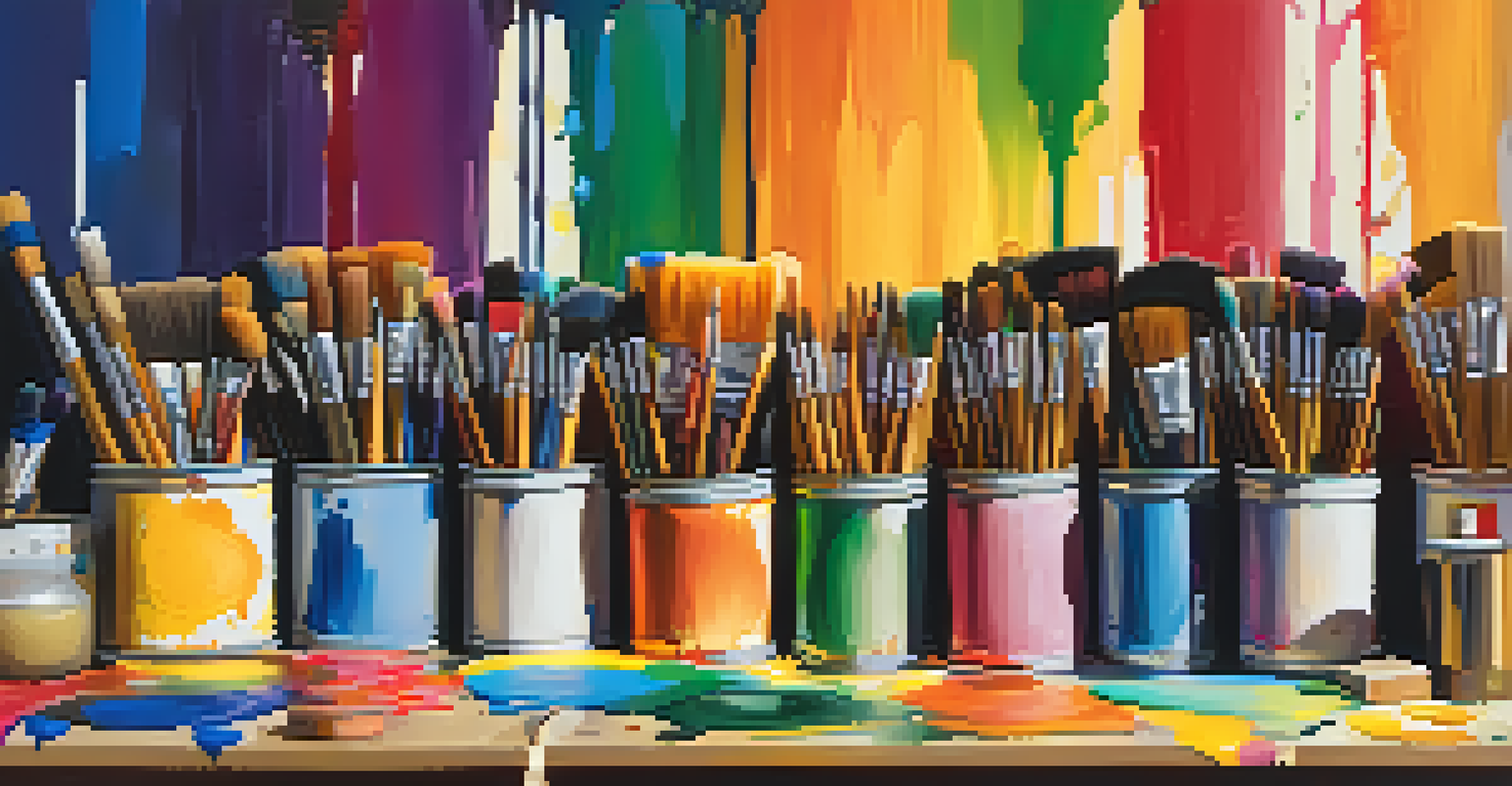Color Therapy: The Psychological Effects of Color in Art

Understanding Color Therapy and Its Origins
Color therapy, also known as chromotherapy, is a holistic healing practice that uses colors to influence mood and well-being. The concept dates back to ancient civilizations, where colors were believed to hold specific powers that could heal the mind and body. By understanding how colors affect our emotions, we can tap into their potential to enhance our daily lives.
Color is the keyboard, the eyes are the harmonies, the soul is the piano with many strings.
Different colors evoke different psychological responses; for example, blue is often associated with calmness, while red can stimulate energy and passion. This relationship between color and emotion forms the foundation of color therapy. Artists and therapists alike leverage this knowledge to create environments that promote healing and emotional balance.
As we explore color therapy, it’s essential to recognize that individual experiences may vary. Cultural background, personal preferences, and even context can play a significant role in how we perceive and react to colors. This subjectivity makes color therapy both a fascinating and complex field.
The Psychological Effects of Different Colors
Each color has its own unique psychological effect, influencing our thoughts and feelings in various ways. For instance, yellow is often linked to happiness and optimism, while green is associated with tranquility and growth. Understanding these associations allows artists to intentionally evoke specific feelings in their viewers.

In art, the strategic use of color can transform a piece from simply visually appealing to emotionally impactful. A painting that employs warm colors may create a sense of warmth and comfort, whereas cooler tones might evoke feelings of sadness or introspection. This interplay between color and emotion underscores the power of visual art as a form of expression.
Color Therapy Enhances Well-Being
Color therapy uses the psychological effects of colors to improve mood and emotional health.
Moreover, the combination of colors can also create complex emotional responses. For example, a piece that uses both vibrant reds and soft blues might convey a sense of tension or balance, inviting viewers to explore their own feelings. This complexity highlights the importance of considering color choices in artistic creation.
Color in Art: A Tool for Emotional Expression
Artists have long recognized the power of color as a means of emotional expression. By choosing specific hues and shades, they can communicate feelings and moods that resonate with viewers on a deeper level. This connection is what makes art a powerful tool for healing and self-discovery.
Colors, like features, follow the changes of the emotions.
For instance, Vincent van Gogh used vibrant colors in his paintings to express his emotional state, often reflecting his struggles with mental health. His iconic use of yellows and blues creates a sense of movement and emotion that draws the viewer in. Such examples highlight how color can serve as a language of its own within art.
Through color, artists can share their personal stories and connect with audiences in a profound way. This emotional resonance can lead to catharsis for both the creator and the observer, illustrating the therapeutic potential of engaging with art and its colors.
The Role of Color in Art Therapy Practices
Art therapy combines creative expression with psychological healing, and color plays a vital role in this therapeutic process. By engaging with colors, individuals can explore their emotions and experiences in a safe space. This exploration can lead to greater self-awareness and emotional release.
In art therapy sessions, clients might be encouraged to use specific colors to express feelings that they struggle to articulate verbally. For example, someone dealing with grief might choose dark colors to represent their sadness, while another person might select bright colors to symbolize hope. This non-verbal communication can be incredibly powerful in facilitating healing.
Art as Emotional Expression Tool
Artists utilize color to convey emotions, creating deeper connections with viewers and promoting healing.
Moreover, the act of creating art with color can serve as a form of mindfulness, helping individuals focus on the present moment. This therapeutic practice not only aids in emotional processing but also encourages relaxation and stress relief, further illustrating the benefits of color in art.
Cultural Perspectives on Color and Emotion
Cultural backgrounds significantly influence how colors are perceived and interpreted. For instance, while white is often associated with purity and peace in Western cultures, it may signify mourning in some Eastern cultures. Understanding these cultural nuances is essential for artists and therapists alike when considering the emotional impact of color.
This cultural context can enrich the interpretation of art and color therapy practices. Artists who are aware of these differences can create works that resonate across diverse audiences, fostering a deeper connection through shared emotional experiences. For example, a mural that incorporates colors significant to various cultures can celebrate diversity and unity.
In this way, color transcends mere aesthetics; it becomes a bridge for communication and understanding. By acknowledging and respecting cultural perspectives on color, we can enhance the therapeutic potential of art in a multicultural world.
The Science Behind Color Perception and Emotion
While color therapy is rooted in psychological principles, scientific research has also explored how colors affect our brains and emotions. Studies have shown that certain colors can trigger physiological responses, such as increased heart rate or relaxation. This scientific backing adds credibility to the practices of color therapy and art.
For example, research indicates that exposure to blue light can improve mood and enhance cognitive function, while red light may increase alertness and energy levels. These findings suggest that the effects of color are not merely subjective but have tangible impacts on our mental states. This intersection of science and art enriches our understanding of color therapy.
Cultural Context Shapes Color Perception
Understanding cultural differences in color interpretation enriches the practice of color therapy and art.
By integrating scientific insights with artistic practices, we can create more effective therapeutic environments. Whether in a therapist's office or an art studio, understanding the science of color can help enhance emotional well-being and promote healing.
Practical Tips for Using Color Therapy in Daily Life
Incorporating color therapy into your daily life doesn't require you to be an artist; simple adjustments can have a significant impact. Start by paying attention to the colors in your environment, whether it's your home decor, clothing, or artwork. Surrounding yourself with colors that uplift your mood can create a more positive atmosphere.
Consider creating a personal color palette that resonates with your emotions. For instance, if you find solace in greens and blues, try incorporating those into your living space or wardrobe. This intentional choice can help you cultivate an environment that supports your emotional well-being.

Additionally, engage in creative activities that utilize color, such as painting or coloring. These activities not only serve as a form of self-expression but also offer a therapeutic outlet for processing emotions. By actively engaging with color, you can harness its power to enhance your mood and overall mental health.